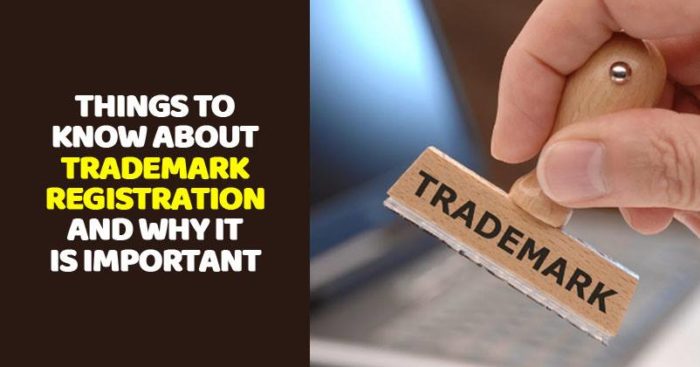Registration of Parts of Trademarks – Trademark Registration in Cochin
Trade Marks Act, 1999
Notes on Clauses.-This clause provides for registration of parts of trademarks and of trademarks as a series subject to certain conditions enumerated therein. This corresponds to section 15 of the existing Act, except consequential amendments to cover services.
Comments-This section provides for registration of parts of a trademark label and also trademarks as a series. This provision corresponds to section 15 of the 1958 Act. Where a trademark applied for registration consists of more than one feature, and in such cases if the proprietor claims to be entitled to the exclusive use of all such features separately, he may seek trademark registration thereof for each such part as a separate trademark, besides registering the whole label as a distinct registration. Sub-section (2) enacts that each such separate trademark shall satisfy all the conditions applying to, and have all the incidents of an independent trademark. In other words, each such application will be examined independently to determine its registrability and will be subject to all the subsequent procedure such as advertisement of the mark before registration, opposition, registration, renewal, etc.
Sub-section (3) makes provision for registration of trademarks as series in respect of the same or similar goods/services where the marks, while resembling each other in the material particulars thereof, yet differ in respect of
- Statement of goods or services in relation to which they are respectively used or proposed to be used; or
- Statement of number, price, quality or names of places; or
- Other matter of a non-distinctive character which does not substantially affect the identity of the trademark; or
- Color
The series trademarks, as the name implies, consists of a series of the same trademark, differing only in respect of particulars set out above. To qualify for registration as a series, the marks should resemble each other in their material particulars and differ only in matters of non-distinctive characters, which does not substantially affect or alter the identity of the mark.
In matters of non-distinctive character
An applicant may seek to register a number of labels, say for fruit jams. While the main feature of the trademark remains the same, there may be variations in the description of names and/or pictures of the respective fruits appearing on the label. In such cases, though the labels are separate, with a common distinguishing feature, the labels will be registered as trademarks of series. The marks in series, while resembling each other in the material particulars, may differ in respect of statement of the goods or services, as to the number, price, quality or names of places, conventional design or ornamentation etc. e.g. “No.1 quality” “Seconds” “bleached” etc.
Practice in respect of letters or numerals for series registration
Marks constituted by three letters (three letter mark) or numeral marks consisting of five digits are regarded as capable of distinguishing per se. Accordingly, such group of marks is registered only as independent marks and not as a series. In these cases, the trademarks are not considered as variation marks for acceptance as series registration, as per practice of the U.K. Registry. The same practice is likely to be adopted by the Indian Registry also.
Each of the trade marks in the series must be in respect of the same goods or description of goods or service. It is to be noted that two sets of goods may be goods of the same description, although they may fall in different classes. Where the goods though falling in the same class, are not of the same description, all the marks cannot be registered as a series in one registration. For example, if some of the marks in the series are claimed for cotton yarn and others for sewing thread, series registration is not possible as the goods, although falling in the same class, namely, class 23, are treated by the Trade Marks Registry as goods of different description.
All trademarks registered as a series in one trademark registration are deemed to be registered as associated trademarks under sub-section (4) of section 16.
Color [Sub-sec. (3) (d)]
Section 15(3)(d) provides for registration of trademark in series, where the mark differs only in respect of color. Under section 10, a trade mark may be limited wholly or in part to any combination of colors and any such limitation may be taken into consideration by the tribunal having to decide on the distinctive character of the trademark. Sub-section (2) of section 10 enacts that so far as a trade mark is registered without limitation of colour, it shall be deemed to be registered for all colors. Further, in terms of the definition of trade mark’ under section 2(2Xzb), “combination of colors” could constitute a trade mark to be eligible for registration.
What is, however, envisaged under section 153)d) is ‘colour’ as a non-distinctive feature in each of the series labels applied for registration.
Procedure for series trade mark [Rule 27 of Trade Marks Rules, 2017]
Rule 23 prescribes the application Form TM-A to be used for registration of trademark, which is a general form for different purposes, including a trade mark for registration as ‘series’ under section 15(3).
Application for registration of a series trade mark is to be made on Form TM-M, as the case may be depending upon whether the application is for registration as an ordinary trade mark in series registration or whether it relates to a ‘collective’ or ‘certification’ trade mark in series. As per rule 25, the application must contain a statement of user, unless the mark is ‘proposed to be used, in which case the Registrar may require the applicant to file an affidavit testifying to such user with exhibits showing the mark as used.
The application must contain representations of the mark (8cm x 8 cm). Rule 26 governing representation and additional representations of the mark and related requirements. It is permissible under section 18(2) to file a single application for registration of the same trade mark in more than one class. However each series must be in respect of the same goods or services or description of goods/services. Where a group of marks are applied for registration as a series in one trademark registration and the Registrar does not consider them to be eligible for registration as series marks under Section 15, the applicant will be required to delete any of the marks, which are under objection.
Likewise, at any time before the publication of the application in the Journal, it may be open to the applicant to apply on Form TM-M for division of the application into two or more applications to conform to the provisions of section 15(3) [as permitted under section 22]. In such cases, apart of the divisional fee payable, the applicant will also have to pay the fee for the TM-M application and the prescribed fees for the appropriate number of classes. However, under section 22, the date of making of the application will be deemed to be the date of making of the original application.
Effect of Registration of parts of a trademark
Trademarks Act, 1999 – Notes on Clauses.-This clause which deals with the effect of registration of parts of a mark seeks to omit the provision relating to requirement of disclaimer and to explicitly state the general proposition that the registration of a trademark confers exclusive right to the use of the trade mark taken as a whole and not separately to each of its constituent parts, if any.
Comments.-The provision in section 17 is new and states the effect of registration of parts of a mark under section 15(1) and states the general proposition that registration confers on the proprietor exclusive right to the use of the trademark taken as a whole.
Sub-section (2) enacts that when a trademark-
- Contains any part, which is not the subject of a separate application by the proprietor for registration as a trademark; or
- Is not separately registered by the proprietor as a trademark; or
- Contains any matter which is common to the trade or is otherwise of a non- distinctive character,
Trademark Registration thereof shall not confer any exclusive right in the matter forming only a part of a whole of the trademark so registered.
Provision for ‘disclaimer’ in old Act deleted
Under section 17 of the repealed Trade and Merchandise Marks Act, 1958, the law provided for a disclaimer of any matter, which was considered non-distinctive. This requirement has been discontinued in the present law, as the disclaimed matter at a particular time may become distinctive through use and disclaimer did not prevent the proprietor in acquiring rights in such matters through registration subsequently without disclaimer.
It was also settled law that the trade mark should be considered as a whole and the absence of a disclaimer meant that the trademark registration gave no separate rights in matter which only formed part of the trademark.
Registration may be subject to conditions & limitations
The acceptance of an application for registration of a trademark by the Registrar may be either absolute or subject to conditions or limitations, if any, as he may think fit – section 18(4). Though the Registrar may not require any “disclaimer” as under the old Act, where he considers necessary, he may impose suitable conditions or limitations in public interest.
When a trademark contains a device common to trade or is otherwise of a non-distinctive character the law leaves no doubt that the registration does not confer any exclusive right in the matter forming only a part of the trademark. The disclaimer was only for the purposes of the Act. As held by the Supreme Court “it does not affect the rights of the proprietor except such as arise out of trademark registration. That is to say, the special advantages which the Act gives to the proprietor by reason of the registration of his trademark, do not extend to the parts or matters which he disclaims. …That circumstance, however, does not mean that the proprietor’s rights, if any, with respect to those parts or matters would not be protected otherwise than under the Act. If the proprietor has acquired any rights by long user of those parts or matters in connection with goods manufactured or sold by him or otherwise in relation to his trade, he may, on proof of the necessary facts, prevent an infringement of his rights by a passing off action or a prosecution under the Indian Penal Code. Disclaimer does not affect those rights in any way.”
Exclusive right is for the use of the mark as a whole
The rights of the registered proprietor are very clearly defined in Section 17(1), which explicitly state that the exclusive right is in respect of the use of the trademark taken as a whole. If the proprietor desires statutory protection to the exclusive use of parts of the trademark, he has to apply to register the whole and each such part as separate trademarks. It is obvious that any part containing a matter, which is common to trade or is otherwise of a non-distinctive character, will not be allowed registration, unless the applicant is able to adduce evidence of acquired distinctiveness for such part to claim exclusive right.
Where parts of a trade mark not separately registered is nevertheless itself of a distinctive character, there should be no difficulty for the proprietor to secure a separate registration for such parts.
The law in section 17 is of course subject to the provisions of section 27(2), which expressly enacts that “nothing in this Act shall be deemed to affect rights of action against any person for passing off goods or services as the goods of another person or as services provided by another person, or the remedies in respect thereof.” Thus the common law rights of the proprietor are wholly unaffected and an action for passing off can be maintained even in respect of part of a trademark not separately registered.
In Uttam Chemical Udyog versus Shri Rishi Lal Gupta trading as Rishi Soap Works, the registered trademark was “5-Bhai”, wherein numeral “5” had been disclaimed. On an application for rectification, on evidence the Registrar concluded that the word “Bhai” had become publici juris and as such passed an order imposing a disclaimer in respect of the word “Bhai”. On appeal, the High Court held that the registered proprietor’s contention that the numeral 5 having already been disclaimed, imposition of the disclaimer of the word “Bhai” rendered the registration totally ineffective, was not tenable, as they had still the exclusive right to use the combination of the words “5 Bhai” in relation to the goods. However, they could not restrain others from either using the numeral 5 or the word “Bhai” simpliciter independently or in combination with other words.
In Registrar of Trade Marks versus Ashok Chandra Rakhit Ltd., the Supreme Court observed that “where a distinctive label is registered as a whole, such trademark registration cannot possibly give any exclusive statutory right to the proprietor of the trade mark to the use of any particular word or name contained therein apart from the mark as a whole”. This decision was followed in Godfrey Phillips India Ltd., versus Girnar Food & Beverages Pvt. Ltd., where the Apex Court held that the plaintiff could pray for an injunction of passing-off despite a disclaimer. To the same effect is the decision in Charan Das & M/s. Veer Industries (India) versus M/s. Bombay Crockery House, where the plaintiffs’ mark was ‘PERFECT’ and ‘SWASTIC PERFECT’ and it had disclaimed the word ‘Perfect’.
In International Foodstuffs Co. LLC versus Parle Products Pvt. Ltd, the Bombay High Court observed that “when a trademark consists of several matters, its trademark registration shall confer on the proprietor exclusive right to the use of the trademark taken as a whole”.
The very many differences in color, trade dress, the goods themselves and their pricing should not be ignored because of a phonetic similarity. No law says that all this must be ignored, or that a solitary test of pronunciation will suffice to defeat all else that weighs against. In the instant case, the plaintiffs had sought injunction only on the basis of phonetic similarity and the court ruled that this was not a sufficient warrant for an injunction and hence, the case was dismissed. For more clarification about trademark registration in cochin, kindly visit our site and feel free to contact us…We are here to help you… Thanks for reading!!!!






